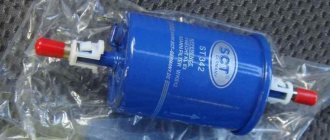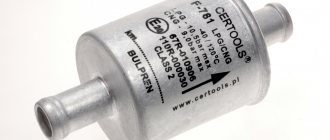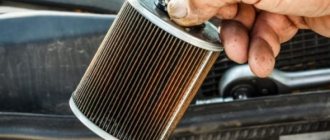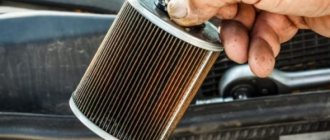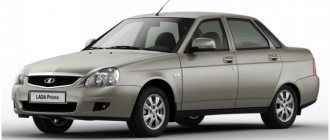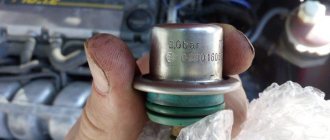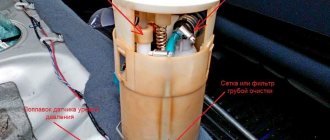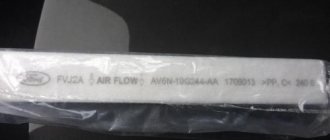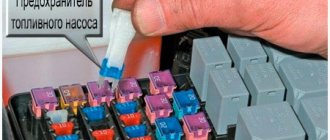Any car works due to the transformation of energy that is released during the combustion of the combustible mixture. Thanks to the vehicle's power system, fuel, as part of the combustible mixture, enters the cylinders. To ensure proper operation of this system, the fuel must be free of various impurities, as they can cause the power system to fail. Also, mechanical impurities have abrasive properties, which threatens damage to some injector components.
If the car's power system is injection, then mechanical impurities can damage or bind the precision pairs with which gasoline is dosed in the car. Their breakdown, therefore, leads to the failure of the injector. The diesel power system is most vulnerable to the presence of mechanical impurities in the fuel, since precision vapors are also present in the high-pressure fuel pump. Consequently, any vehicle power system must be equipped with fuel filters, the main purpose of which is to clean the fuel from mechanical impurities.
Where is the fuel filter located?
When asked where the fuel filter is located
fine cleaning cannot be given a definite answer, since its exact location depends on the car model and the type of fuel system implemented in it.
But in any case, it is installed between the engine and the fuel tank. Often the filter is installed - under the hood
,
under the bottom
or
in the fuel tank
of the car along with a fuel pump and a coarse fuel filter.
In a carburetor system
The filter is installed
in front of the carburetor
. Most often it is made in a transparent housing to facilitate control of clogging. This design allows you to visually determine when changing the fuel filter becomes extremely necessary. Filters for carburetor engines are the simplest, since such engines are not too demanding in terms of the purity of the fuel mixture.
FAQ
Where is the fuel filter located?
The exact location of the fuel filter depends on the vehicle's layout. On carbureted cars it is usually located under the hood near the carburetor. In diesel cars, in the engine compartment between the high-pressure fuel pump and the engine. On injection cars it can be located under the bottom, in the engine compartment or in the fuel tank, in the fuel pump module. Exact information about the location of the fuel filter is indicated in the vehicle's operating instructions.
What does a fuel filter look like?
In carburetor cars, it looks like a transparent plastic case with a filter element inside. In modern cars, due to the high pressure in the fuel system, fuel filters are made as more massive metal or thick plastic flasks with filter elements inside. The average filter dimensions are from 10 to 20 centimeters in height, up to 10-12 centimeters in diameter, although deviations are possible. Diesel fuel filters can be more complex in design because they must filter out moisture and wax.
How does a fuel filter work?
The fuel enters the filter housing, passes through the layers of the filter element and leaves the filter clean and further into the fuel system.
When do you change the fuel filter?
The exact time frame for replacing the fuel filter is in the car’s manual or you can find it out at an authorized dealer’s service station in the car’s technical inspection manual. All other recommendations can be considered too average to advise all of them to car owners. The average service life of a fuel filter is at least 40-60 thousand km. Change when symptoms of clogging occur or in accordance with the maintenance regulations.
Related terms
- Gasoline pump
- Carburetor
- Fuel pump
Purpose of fuel filters
Modern cars are extremely sensitive to fuel quality. The fuel sold at gas stations already contains foreign impurities.
Read also: Atherosclerosis of the carotid arteries
In addition, water, rust from the walls of steel tanks, dust and dirt from the refueling nozzle get into gasoline or diesel fuel.
Modern cars are sensitive to fuel quality
In injection systems, mechanical impurities in the fuel can cause premature wear and, as a result, failure of the injectors and fuel pump.
The filter removes condensation and contaminants before fuel enters the system, thereby preventing unpleasant consequences.
Moreover, the combustion efficiency of purified fuel is noticeably higher. As a result, engine power increases.
As a result of untimely replacement or failure of the fuel filter:
- there are problems starting the engine;
- blockages form in the fuel lines;
- individual elements of the injection system wear out;
- the carburetor becomes clogged;
- fuel consumption increases.
Stages of diesel fuel purification and types of filters
The first obstacle to suspended particles in the fuel is the filter element in the fuel tank of the car. As a rule, it is a frame sealed in a mesh, which is a barrier to solid particles. This type of cleaning cannot prevent small particles, water, paraffins and resins from entering the fuel equipment.
But thanks to it, most of the large elements - corrosion products and debris - are eliminated. They are present in any fuel tank. This prevents clogging of low-pressure lines, and also significantly increases the service life of the coarse filter.
In most cases, replacing this element is not regulated by the manufacturer, but it is recommended. Its service life directly depends on the newness of the car, its technical condition and fuel quality. The mesh element in the car tank is the cheapest link in the entire chain of fuel supply to the engine, but no less important, so you should not neglect checking it and, if necessary, replacing it.
The second stage is carried out by “coarse” fuel filters (sediment filters). Their name is due to the presence of a settling glass. In the lower part it is equipped with a damper, thanks to which it is possible to remove water.
And in its upper part there is a mesh or plate filter element, which allows you to get rid of particles up to 0.05 mm in size remaining after the first stage. Next, the fuel enters the low pressure fuel pump (LPFP).
This type of filter has a drain plug to clean the glass from condensation and sediment. Most sediment filters have a collapsible design. This design of the diesel engine fuel filter makes it possible to wash and, if necessary, replace the filter element and thereby restore cleaning efficiency.
A special type of filter at this stage are heated separators for diesel fuel. Their price is significantly higher than that of conventional settling filters, but the quality of fuel purification is more effective, and heating solves the problem of paraffins. They are capable of removing up to 95% of water and impurities from diesel fuel.
The cleaning process begins with the fuel heating stage, which prevents the crystallization of paraffins and water. Then, under the influence of centrifugal forces that arise when the emulsion swirls and passes through special channels, water and impurities are separated and deposited in the settling glass.
To separate smaller particles, the principle of changing the direction of flow is used, which is implemented using separator blades. The final stage is a corrugated cartridge that removes the smallest solid particles.
Often there are “coarse” filters connected to a booster pump or a “fine” filter.
In most cases, contamination of “coarse” filters will not be noticeable during vehicle operation, because The performance of the injection pump is always higher than necessary for stable engine operation. Therefore, in order to prevent costly repairs, it is necessary to promptly remove accumulated water and debris from the sump and not ignore the need to replace the filter element.
It is recommended to check the presence of sludge and condensate daily. During the cold season, it is better to do such a check after each trip. The service life of the filter element does not exceed 15-30 thousand km.
The final barrier for fuel before it enters the diesel engine is a fine filter. It allows you to get rid of the solid particles remaining in the previous stages that are not visible to the eye, as well as the formed resins. Another of its functions is to protect the engine from air that gets into the fuel during the early stages of cleaning.
Through the jet valve, air with excess fuel is discharged back into the tank. The temperature difference between the exhaust mixture and the fuel in the tank contributes to the formation of condensation and an increase in water content. The “fine” cleaning function at this stage is performed by a replaceable element consisting of special porous paper.
Features of diesel fuel filters
The main task of diesel fuel purification is to prevent condensation from entering the engine.
In most cases, water is separated from the fuel by a separator filter.
The diesel fuel filter must heat the fuel and protect the engine from condensation.
In addition, the properties of diesel fuel change with decreasing temperature.
Therefore, the filter must be adapted to the cold. This problem is solved by adding a heating system to the filter (for example, a curtain can be paper, capable of conducting current).
This way, the optimal temperature of the mixture of cold fuel from the tank and heated fuel from the filter is maintained.
Some models of fuel filters for diesel engines have a system for separating condensate and sensors that indicate the water content in the fuel.
Purpose of filters for cleaning diesel fuel
Diesel filters have a limited service life ranging from 15 to 40 thousand kilometers. This period depends on the quality and degree of contamination of the fuel being refueled. A decrease in filter throughput means that the filter element in the filter housing is clogged. At an early stage, this leads to a drop in traction and jerking when moving under load. If the fuel filter of a diesel engine is dirty, the engine responds with a delay when pressing the gas pedal, may operate unstably in idle mode, etc.
The design features of a diesel engine and the type of fuel used in it require increased requirements for the purity of the fuel supplied from the fuel tank. Fuel filters in the power supply circuit of a diesel engine are an important element, since the filter element serves as multi-level protection for the extremely sensitive fuel equipment of a diesel engine.
Such equipment does not allow the presence of mechanical particles, water, air and other impurities in the fuel. A high-pressure fuel pump (HPF), diesel injectors and a high degree of compression in the cylinders of a diesel engine imply the use of only clean diesel fuel, which also has sufficient lubricating properties. The gaps in the design of the injection pump plunger pairs are extremely small; any mechanical particles in the fuel lead to wear of the high-pressure pump. Pollution and impurities in diesel fuel form deposits, clog diesel injectors, etc.
It turns out that the overall reliability and service life of a diesel engine directly depend on the state of the unit’s power system. Effective cleaning of diesel fuel with fuel filters becomes a paramount task. Another characteristic feature of filters for diesel engines is the maximum prevention of water entering the engine cylinders.
The property of diesel fuel to lose fluidity at low temperatures and become waxy poses an additional threat to fuel equipment. For this reason, diesel fuel filters can also be equipped with additional heating elements to warm up diesel fuel, which allows the use of a diesel internal combustion engine during cold periods.
How often to change the fuel filter
“The life of the fuel filter is set by the car manufacturer and depends on the model, type of fuel and its quality,” says Konstantin Epaneshnikov, director of service and spare parts at AVILON Volkswagen . — For passenger cars, it can be equal to 40 thousand km, 60 thousand km, or not change at all, that is, have a resource equal to the service life of the car. Such filters are usually installed on modern gasoline cars and are located in the fuel tank.
Some car enthusiasts change fuel filters at almost every technical inspection - they say, this way the engine works more powerfully. You shouldn't do this. The fuel filter is a delicate matter, it is not located in the most sterile conditions, so with each replacement, especially if it is not done by a specialist, there is a high risk of introducing additional “infection” into the system. Which will not “cure” the car, but will only harm it.
Replacement on different types of engines
Regardless of what make and year of manufacture your car is, you will need a standard set of tools to dismantle and install the filter element:
- open-end wrenches;
- screwdriver with a thin flat blade;
- pliers;
- WD-40;
- clean fuel container;
- rags.
How to remove a filter from a carburetor engine
The procedure is made as easy as possible by the fact that the filter is installed in the engine compartment of the car. That is, it is enough to wait until the engine cools down, and then begin dismantling.
Important! Before directly removing the part, you need to relieve the pressure in the system. To do this, remove the wiring harness from the fuel pump to stop the power supply. After which the engine starts and runs until it stalls due to lack of fuel.
The order of work after releasing the pressure in the fuel system looks like this:
- Open the hood.
- The filter itself is located near the brake fluid reservoir, near the carburetor.
- Unscrew the clamps securing the two hoses.
- Remove the fuel hoses from the sides. Fuel may leak, so it is better to place a container or a rag under the holes in advance.
Disconnecting the fuel lines
Accordingly, installation of the new element is carried out in the reverse order.
How to remove the fuel filter on injection car models
The work will be somewhat more difficult than in the previous case. On injectors, the part is located under the bottom, so you will first need to either drive the car into an inspection hole or jack it up high.
In this case, the precautions will be the same as when working with carburetor engines: before dismantling, you will need to relieve the pressure in the system. Further work is carried out according to the following scheme:
- Find the fuel pump in the center of the rear beam.
- It is usually difficult to unscrew the nuts the first time, so it is recommended to lubricate the joints with WD-40 first.
- After this, unscrew the two connecting nuts and remove the fuel pipes (place containers in advance to drain the remaining fuel).
- Remove the filter along with the rubber seals from the bracket.
- After which you can install a new one in the free space.
The main thing is to create comfortable working conditions
What types of fuel filters are there?
To determine the answer to the question of which fuel filter to choose, it makes sense to find out its possible types. After all, depending on the fuel system and the filter, they are made differently, with varying degrees of filtration. Yes, they are:
Carburetor . Installed on appropriate gasoline engines in close proximity to the carburetor. Their design is the simplest, and cleaning is rough. Such fuel filters are required to clean 5...25% of particles with a size of 3...5 microns.
Injection . They are installed on injection gasoline engines in the gas tank or immediately after it outside. They have better filtering ability compared to carburetor engines. So, with their help, dirt particles measuring 10 microns or more are filtered out (also depends on the specific filter). It is important that such filters can operate at a pressure of about 3...4 bar.
As for the degree of their filtration, it depends on the injection system:
- distribution injection - 25...65% for particles 3...5 microns;
- traditional direct injection systems - 48...70% for particles 3...5 microns;
- the latest direct injection systems - 85...95% for particles 3...5 microns.
Diesel . The most complex fuel filters, since their task is to sift out not only dirt particles, but also water and paraffin. A modern fuel filter should filter out 2 microns, since the equipment is more accurate and operates under higher pressure. Please note that while old (“classic”) diesel systems operated at pressures of up to 2000 bar, modern Common Rail systems develop pressures of up to 2500 bar. Accordingly, fuel filters must be designed to work with it.
Similarly, for diesel filters, filtration gradation is assumed:
- for classic old-style engines - 25...65% for particles 3...5 microns;
- for classic Common Rail systems - 85...95% for particles 3...5 microns;
- for the latest Common Rail systems - 98% for particles 2 microns in size (so-called 2 micron fuel filters).
Regardless of the type of fuel filter, they should filter up to 95% of the moisture present in the fuel. In fact, many of the given values are overestimated, and only a few manufacturers are capable of producing filters with such high performance.
However, the type of device is the first, but not the only criterion by which it is determined which fuel filter is best installed.
When is it time to change
You can buy yourself a new TF literally as soon as you purchased the car from the showroom or took it from your hands. But after how long can it or should it be changed?
If you change the TF on a used car as soon as you re-register it, nothing bad will happen. It is not known what kind of filter was there before and how many kilometers it has already traveled and how long ago the previous owner changed it.
The frequency of TF replacement can vary significantly depending on a number of factors:
- vehicle condition;
- driving style;
- terms of Use;
- fuel system operation;
- the quality of repairs performed regarding the engine and fuel system;
- the quality of the gas stations where the previous owner of the used car refueled;
- engine's type;
- motor power, etc.
Only the specific instruction manual can answer you. And how often the TF changes depends on you specifically.
In general, I’ll tell you, many people believe that on diesel cars the TF is changed every 30 thousand kilometers, and on gasoline cars - from 60 to 100 thousand kilometers. And some automakers even say that the filter installed from the factory will last as long as the car itself.
Alas, these numbers are far from the truth. Why? It's simple. Ideal operating conditions are taken into account here. That is, smooth roads, high-quality fuel, measured driving style, and so on. Which of these do you have? Personally, I have problems on all counts, since driving on our roads in this way is impossible, even with a strong desire.
Therefore, the reality is that diesel filters are changed every 10-30 thousand kilometers, and gasoline filters - 20-60 thousand. Yes, there are exceptions when the car is rarely used, the driver is extremely careful and refuels at the best gas stations. Here the filter can really last 50-100, or even more than thousands of kilometers.
I will give one piece of advice that is far from bad. Take into account the mileage and compare it with the operating conditions of the vehicle. This way you will understand exactly how often you should change the TF.
A car is such an advanced invention that it itself will show signs indicating the need for replacement.
Which filter is better to choose?
This question is asked to specialists most often, because in most cases the car owner buys the necessary set of spare parts for maintenance himself.
When choosing, first of all you need to find those filters that are suitable for the model and modification of the car. And it is better not to try to modernize the design of the car by installing, for example, a diesel filter in a gasoline engine.
After that, decide on the choice of brand. Everything is simple here: if you want a filter “for yourself” so that you can drive calmly and not count kilometers, choose high-quality brands of the highest category. If you want to carry out the last maintenance before selling, normal budget options are also suitable.
However, most people prefer the best price and quality offers by choosing mid-priced brands. These include, first of all, Bosch, which has long been loved by customers.
Fine oil filter
The oil circulating in the engine contains resinous substances, tiny chips formed during friction of engine elements, as well as coking products. The lubricant moving along the main pipeline passes through oil filters on each circle, which trap contaminants that have entered the liquid from the outside or formed during the operation of the power unit.
Principle of operation
The fine oil filter (FFO) is mounted on the right side of the internal combustion engine. It is fixed to the front radiator shield using a bracket.
In order for the part to ensure good cleaning of the lubricant, it is tested during production, during which the completeness of screening is determined. It must be at least 25%. For testing, an artificial pollutant is used - quartz dust, and the specific surface area should be 5600 cm / g.
The fine filter is installed in the lubrication mechanism parallel to the main oil line. Approximately 20% of the total amount of liquid material supplied by the blower passes through the purifier.
Engine oil is supplied to the FTO and removed from it through flexible hoses. The lubricant enters through the main pipeline, and then through the fitting, which is located in the cover of the pusher cavity, is sent to the oil sump.
Is a filter really necessary? What does it affect?
First of all, the purity of gasoline is important for the injectors of an injection engine: their thinnest holes become clogged with deposits of paraffins, sulfur, dust, dirt and other “goodies.” This is followed by deterioration in engine performance (after all, the required amount of fuel does not enter the cylinder and is not dissipated properly), loss of power, “triple”, when an injector in one of the cylinders fails, and after that - expensive repairs. For systems with a fuel injection pump (high pressure fuel pump), cleaning is carried out before fuel enters the pump: the fine fitting of the parts does not withstand foreign impurities. Buying a new pump also costs a considerable amount.
Clogged injectors
The procedure for replacing fuel filters on a VAZ 2107
Any mechanism in a car will sooner or later need replacement or restoration. It should be noted that owners of VAZ 2107 carburetor models have the opportunity to wash the filter, removing all deposits from it, and use it again. The installed filters on injection VAZs cannot be washed.
When to change
In any case, it is more advisable to immediately replace the fuel filters rather than waste time washing and cleaning them. Not all car enthusiasts know when exactly these elements need to be replaced. Of course, each filter (coarse and fine) has its own designated resource, but you should not wait until it runs out.
As a rule, obvious signs of malfunctions in the operation of the fuel system filter elements are:
- jerks and failures in the operation of the power unit (the first signs can be noticed at low speed or in idle mode);
- decrease in traction when accelerating, overtaking, driving uphill;
- problems starting the engine;
- increased fuel consumption.
According to regulations, the need to replace VAZ 2107 fuel filters occurs on average after traveling 30 thousand kilometers.
If it is heavily contaminated, the filter will not allow gasoline to pass through in full, which is why problems with engine operation begin.
Which filter to buy
If the car owner intends to change the filter on a VAZ 2107 on his own for the first time, he will need to choose the best option in the store. It is important to know that the prices of analogues from domestic and Western manufacturers are approximately the same, however, experienced car owners are advised to choose Mahle and Big filters. These devices are more reliable and durable, and the risk of purchasing a defective filter is virtually eliminated.
You can evaluate the effectiveness of the filter by its manufacturing quality and paper quality. The best way is to disassemble the used filter. Those. We remove the used filter, saw it and see how and what it is made of. I have never seen anything better than the MAHLE KL83. There are no springs inside, the paper filters perfectly (black on the outside and light on the inside), the filter paper is not glued to the body (i.e. no glue is used), but is pressed into liquid plastic, which, after cooling, ideally maintains the pitch between the corrugations. Aluminum body. I sawed ZOLEX, SCT and FILTRON. These MAHLE filters don't even hold a candle. The paper frays on them. But this is my purely personal opinion.
Alexei
https://www.autolada.ru/viewtopic.php?t=220918
One of the most popular filters among car enthusiasts
How to make a choice
When choosing a fuel filter, you should pay attention to:
- Device bandwidth. The coincidence of the diameters of the filter inlet and outlet fittings with the diameter of the fuel pipe tube is a sure sign of suitability, but it never hurts to clarify the parameters;
- Filter service life declared by the manufacturer. Avoid purchasing fuel filters, the manufacturers of which guarantee the constant performance of the device throughout the entire service life of the vehicle;
- Manufacturer's reputation. Little-known manufacturers can place a plastic mesh wrapped in a blotting cloth in the filter, sell the batch at a dumping price - and disappear from the market forever.
Purchasing a new item
When choosing this element, be sure to pay attention to the following parameters:
- filtration level. If it is insufficient and large particles nevertheless penetrate into the system along with the fuel, this will very quickly lead to engine failure;
- the area of the filtration element, as well as the presence of a rubber seal that covers the entrance to the filter itself. If there is none, this part will be very problematic to replace.
Depending on the fuel system, fine filters are divided into:
- carburetor, permissible degree of purification is 15-20 microns (smaller particles will pass into this system, but will not harm the fuel delivery system to the engine);
- injection, finer degree of purification, 5-10 microns (in such systems, the requirements for the maximum size of permissible contamination are higher, i.e. the injector can become clogged with larger particles, so the holes in the filter are smaller);
- diesel engines are capable of retaining not only very small solid particles (less than 5 microns), but also removing moisture, and this is very important for a diesel engine.
When purchasing, it is important to tell the seller the make and year of your car in order to choose the right filter. For the most part, if there is no product specifically for your case, then you can choose something interchangeable. But there are cases where this is not possible, so check your vehicle's manual for this information.
Installation of fine and coarse fuel filters
Two types of filter elements are often installed on modern cars:
- rough cleaning;
- fine cleaning.
The coarse filter has a metal body and mesh-shaped insides, which allows it to trap particles with a length of more than 0.1 mm. That is, rough fuel purification involves the elimination of the largest contaminants.
Predominantly injection cars are equipped with a fine filter, since their performance depends entirely on the quality of fuel purification. The mechanism is a plastic case with cardboard inserts inserted into it. Special paper traps the smallest particles in the fuel flow, which contributes to high-quality fuel purification.
That is, the mesh and paper liners are designed to trap particles of dirt and impurities, preventing them from penetrating into the engine cylinders.
Some manufacturers install combined filter models (coarse and fine cleaning are carried out by one device - a seperator)
What happens if the fuel filter is clogged?
The filters are, of course, damaged by the dirt that gets into the tanks of our cars along with the fuel. And it’s not the oil refineries that are to blame. Fuel can become contaminated during storage and transfer. And the driver will feel the clogging of the fuel filter by the behavior of the car, and first in those modes where the instantaneous fuel consumption of the engine is maximum. These are driving modes at high speeds and intense acceleration. In this case, the engine will lose traction and operate intermittently, although at idle and in “quiet” modes everything will look decent.
Operating principle of TF
TF works according to the following scheme:
- When passing fuel through a filter, it first passes through the inlet fitting and then through a coarse gas filter;
- the mechanical components of the diesel fuel are held in place by paper “curtains” of the filter;
- fuel, purified from impurities, is supplied to the fuel line.
Automotive oil filters are made using similar filter paper as fine gas filters.
In the fuel systems of cars of foreign brands, fuel filters of a more complex design, consisting of three fittings, are installed. Since the fuel system of such machines consists of a main and an additional line, the fittings are placed as follows: two go to the main line, one to the additional line. The latter is intended to relieve pressure in the system by dumping excess diesel fuel back into the fuel tank.
Filter elements of a more complex design are installed in cars of foreign brands
